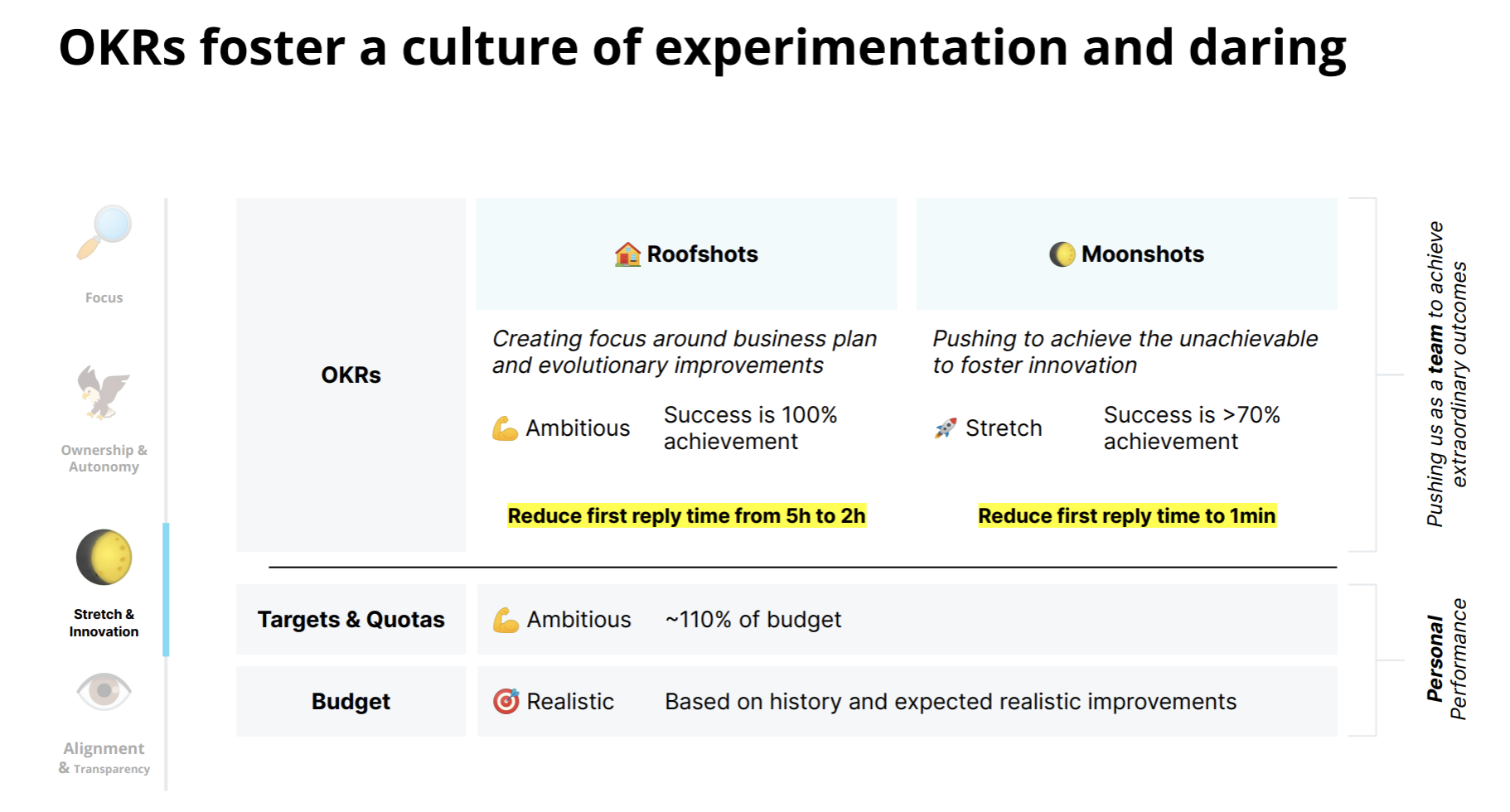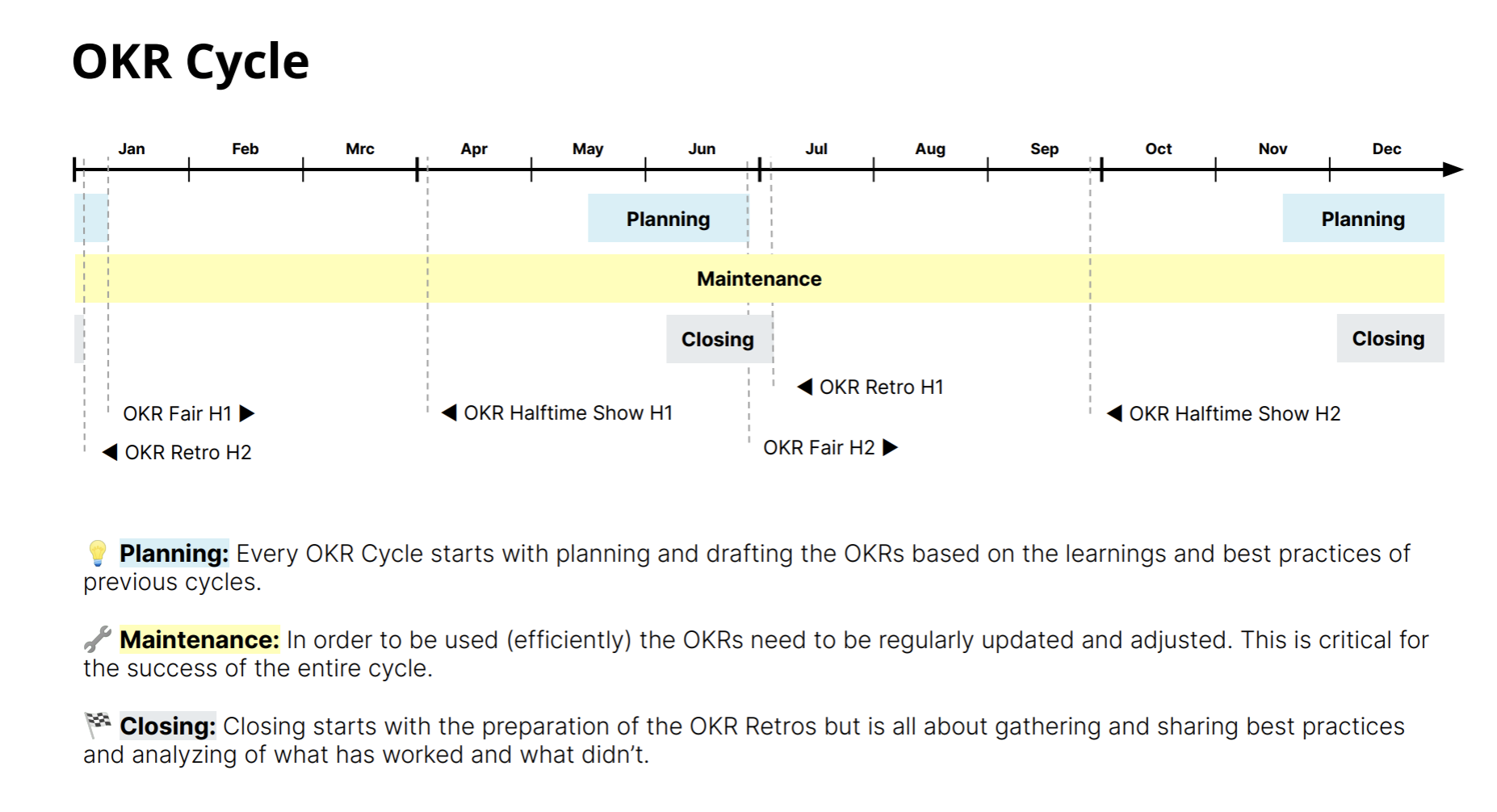As most business strategies deliver only 63% of their potential financial performance, it’s a common concern companies share worldwide, regardless of their market and geography.
During our 21st OKR Champions Roundtable event, Personio's Micaela Arizpe (Senior Operations Manager, COO Office, and OKR Champion) shared how Personio is closing the strategy execution gap.
By leveraging OKRs, Personio cultivates laser-sharp focus and promotes a culture of ownership, innovation, and alignment.
Why does Personio use OKRs?
As Europe’s leading HR software company for SMBs, Personio is valued at $8.5 billion, with more than 1,600 employees working to build continuous brand success. The company uses bi-annual OKRs as its goal-setting approach to handle complex operations. Here’s why:
- Focus: Ensuring employees contribute to key company goals
- Ownership and autonomy: Empowering employees to achieve goals
- Culture of innovation: Pushing employees toward ambitious long-term objectives
- Alignment and visibility: Connecting employees across departments and teams
OKRs set focus
Personio establishes focus by distinguishing between KPIs and OKRs. While KPIs are vital for measuring relevant success metrics, OKRs enhance focus on the most critical strategic items. This approach helps Personio adapt to changing circumstances while maintaining momentum, distraction-free, toward long-term goals.
OKRs drive ownership and autonomy
At Personio, outcome-driven key results give individual teams the freedom to define how they’ll achieve their goals without a prescriptive approach.
To illustrate, consider a restaurant — ingredients are inputs, meals are outputs, and customer satisfaction is the outcome. Personio's outcome-focused OKRs give its teams the flexibility to achieve this outcome, or cook their meal, how they see fit.
"Having an outcome KR gave the team freedom to experiment and try other tactics. At the end of the OKR period, they achieved 80% on their KR."
OKRs foster a culture of innovation
Personio categorizes its OKRs into two types: roofshots and moonshots. Roofshot OKRs are fundamental and require 100% attainment, while moonshot OKRs are ambitious and involve out-of-the-box thinking.
- Roofshot OKR: Reduce reply times from five to two hours by optimizing support processes
- Moonshot OKR: Reduce first reply time to one minute
"The answer that gets you to that roofshot will have to look different from the one that gets you to the moonshot."
To encourage employees to aim high, Personio doesn’t let OKRs tie into individual performance, reducing the fear of failure and experimentation.

OKRs establish alignment and transparency
When Personio had 200 employees based in Munich, they used to host an OKR fair. Teams would gather at the office, enjoy food and drinks, and browse through booths showcasing teams’ OKRs and strategies for the next six months.
However, when the pandemic hit, they needed an alternative — Miro boards and online treasure hunts stepped in to create transparency and ensure everyone understood what the company, departments, and teams were trying to achieve.
Personio’s OKR fair is an evolving event that promotes cross-functional collaboration and ensures everyone knows their contribution to the company’s success.
What does Personio's OKR process look like?
Personio has built its OKR program for flexibility and scalability — OKR champions are allocated to each OKR-setting team. These OKRs are designed at the company, departmental, and team levels, focusing on goals benefitting the entire organization rather than individuals.
OKR Champions drive OKR within their teams, OKR Ceremonies drive transparency and accountability of results, and Quantive Results consolidates all OKR information and updates into one single transparent interface across Personio.
While running on a bi-annual basis, the program is set to shift to a quarterly cadence soon.
Personio’s OKR cycle
Personio’s OKR cycle involves well-structured planning, maintenance, and closing stages, with each step rooted in learning.
- Planning: Starts based on the previous cycles' learnings and best practices
- Maintenance: Regular updates and adjustments are made throughout the cycle
- Closing: Retrospectives gather and share best practices at the end of each cycle
Three key activities summarize Personio’s OKR cycle: an OKR fair to kick off its bi-annual OKRs, a halftime show to evaluate progress mid-cycle, and retrospectives to promote learning at the end of the cycle. These ensure that the company is constantly evolving to improve its OKR program.

Practical tips for OKR champions
As an OKR expert with years of experience working for a large-scale company, Micaela suggests several best practices for OKR champions:
- Build a cross-functional team of OKR champions: Promote OKRs and facilitate communication and change management
- Invest in education and training: Ensure everyone understands how to define outcomes and write great OKRs — especially if your company is scaling rapidly
- Regularly gather stakeholder feedback: Evolve your OKR process to make it flexible across teams and use cases
- Ensure a solid strategic foundation: Using top-down focus and executive buy-in to demonstrate OKR commitment
- Leverage OKR software: Facilitate visibility, alignment, process optimization, OKR tracking, and check-ins as your company grows — Personio uses Quantive Results to manage their OKRs
Dreams with Deadlines is the one and only strategy meets execution community. We’re a global network of ambitious leaders who are passionate about using OKRs and agile practices to achieve audacious goals and build a better future.
Whether you’re new to OKRs or a seasoned pro, the Dreams with Deadlines community is where you’ll find the knowledge, connections, and resources you need to achieve your goals with greater confidence, efficiency, and impact.
Join for free to get access to our private Slack forum, exclusive events, and curated networking opportunities to fuel your personal and professional growth.





